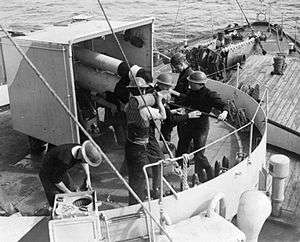HMS Vervain (K190)
 HMS Vervain's 4-inch gun crew in action, July 1942 | |
| History | |
|---|---|
| Name: | HMS Vervain |
| Ordered: | 8 April 1940 |
| Builder: | Harland & Wolff Ltd., Belfast, Northern Ireland |
| Yard number: | 1101[1] |
| Laid down: | 16 November 1940 |
| Launched: | 12 March 1941 |
| Completed: | 9 June 1941[1] |
| Commissioned: | 9 June 1941 |
| Struck: | 20 February 1945 |
| Fate: | Torpedoed and sunk on 20 February 1945 |
| General characteristics | |
| Class and type: | Flower-class corvette |
| Displacement: | 925 long tons (940 t; 1,036 short tons) |
| Length: | 205 ft (62.48 m)o/a |
| Beam: | 33 ft (10.06 m) |
| Draught: | 11.5 ft (3.51 m) |
| Propulsion: |
|
| Speed: | 16 knots (29.6 km/h) |
| Range: | 3,500 nautical miles (6,482 km) at 12 knots (22.2 km/h) |
| Complement: | 85 |
| Sensors and processing systems: |
|
| Armament: |
|
HMS Vervain was a Flower-class corvette of the Royal Navy. She served during the Second World War.
On 28 February 1943 the liberty ship SS Wade Hampton was torpedoed by the German submarine U-405 while sailing in a convoy from New York to Murmansk, Russia. Survivors were picked up by Vervain, SS Bayano and HMS Beverly near Greenland.[2]
On 20 February 1945 at 11.45 hours Vervain was escorting a homeward-bound convoy when she was sunk by a torpedo from an U-boat, U-1276 under Oberleutnant zur See Karl-Heinz Wendt, about 25 miles south-east of Dungarvan, Ireland, south of Waterford. Vervain sank after 20 minutes. Three officers and 30 ratings were rescued.[3]
References
- 1 2 McCluskie, Tom (2013). The Rise and Fall of Harland and Wolff. Stroud: The History Press. p. 149. ISBN 9780752488615.
- ↑ http://newsite.navymemorial.org/nl_tribute_expanded.php?search=yes&fileaddr=MSB94302281
- ↑ http://filestore.nationalarchives.gov.uk/pdfs/small/cab-66-62-wp-45-106-11.pdf
Publications
- Colledge, J. J.; Warlow, Ben (2006) [1969]. Ships of the Royal Navy: The Complete Record of all Fighting Ships of the Royal Navy (Rev. ed.). London: Chatham Publishing. ISBN 978-1-86176-281-8. OCLC 67375475.
- navymemorial.org
- National Archives
External links
| Wikimedia Commons has media related to HMS Vervain (K190). |
- Helgason, Guðmundur. "HMS Vervain". German U-boats of WWII - uboat.net.
Coordinates: 51°47′N 7°6′W / 51.783°N 7.100°W
This article is issued from Wikipedia - version of the 9/5/2016. The text is available under the Creative Commons Attribution/Share Alike but additional terms may apply for the media files.